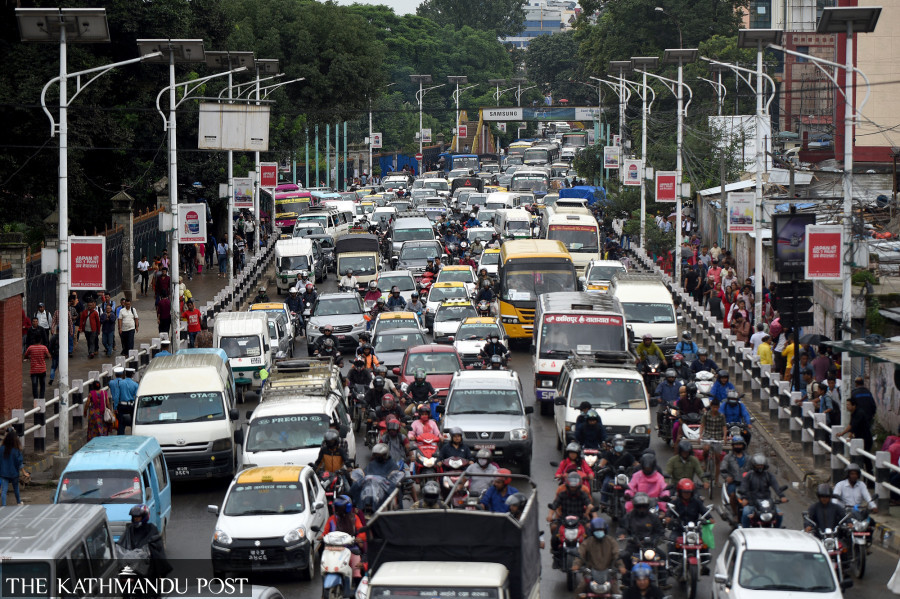Valley
With festivals over and pre-pandemic normal returning, traffic congestion is back
Experts say upgrading road infrastructure and making public transport reliable may provide a long-term solution.
Anup Ojha
Kamala Paudel who commutes from her Pepsicola apartment to Sanepa in Lalitpur daily, complained that her travel time has increased markedly over the past two weeks. Due to a significant increase in road traffic during the morning and evening rush hours and long traffic jams at intersections these days, it takes her over an hour to reach her office on a scooter, she said. The trip would otherwise take her around 20 minutes.
“These days I have to stop at six places in traffic jams on dusty roads. At some stops I get stuck for around 20 minutes, and the traffic jams become much worse in the evening,” said Paudel, 27, who works as an accountant in a private firm.
She said the traffic jam starts from Pepsicola and sometimes it takes over 30 minutes to reach Jadibuti, which is around two kilometers. “The traffic jam from Jadibuti to Koteshwar makes me mad,” said Paudel.
“For the past one year, I had been taking an alternative corridor route from New Baneshwar to the Bagmati corridor, but these days there is a big traffic jam on the bridge at UN park,” said Paudel.
Amit Dhungana, 37, from Goldhunga of Tarakeshwar Municipality-5, said it takes him two hours to reach his office at Babarmahal. So he leaves home as early as possible so as not to be late at the office.
“For nearly two years I worked from home due to the pandemic, but after Tihar they have made it mandatory to work from the office, and the traffic jams have made the commute a nightmare,” said Dhungana.
Dhungana said that in the past few weeks the traffic jam is getting even worse in Kathmandu. “Everyday I have been wasting my four hours in commute,” said Dhungana, a software developer at an outsourcing firm. He said earlier it would take him 45 minutes to reach office by public transport.
Paudel and Dhungana are case in point.
According to traffic police officials, road traffic has increased markedly after the festive season leading to more traffic jams in the Capital.
“These days around 1.6 million vehicles are on the road. As things are returning to pre-pandemic normal, public mobility has also increased in Kathmandu Valley,” said Senior Superintendent of Police Janak Bhattarai, also the chief of Metropolitan Traffic Police Division. He said the traffic jams are getting worse also because people have returned to the Capital after the festivals.
He said in the past two years over 200,000 new vehicles were added in Kathmandu roads. “The vehicle numbers are increasing but the road infrastructure is inadequate and we also don’t have flyovers and underpasses, '' said Bhattarai.
The Division’s report shows that if all the vehicles in Kathmandu Valley were to be queued, they would form a line longer than the total length of roads in the Valley. The report further states that the total road length is 4.5 million feet, whereas the single queue of all the vehicles in the Valley would cross 7.2 million feet.
According to traffic officials, the most traffic jam prone areas are Koteshwar-Jadibuti and Pepsicola area. Another notorious traffic jam these days occurs at Thapathali, as the Thapathali bridge is a bottleneck for vehicles entering Kathmandu from Lalitpur. This causes congestion in the Tripureshwar, Maitighar and Singhadurbar areas.
Urban planners see the present traffic problem leading to an alarming situation. “In the past few weeks the traffic jams are getting more severe and the government should address this problem as soon as possible,” said Suman Meher Shrestha.
He said the main reason for these growing traffic jams is the government's inability to improve public transportation.
According to him, another reason for the traffic jams is that banks are encouraging people to buy vehicles, providing them easy loans. “Since public transport is not reliable people are forced to buy vehicles. An average household in Kathmandu has more than three vehicles,” said Shrestha.
He says the only way to resolve Capital’s traffic congestion is to improve public transport and road infrastructure. “If the government is able to make public transport reliable then people will stop using private vehicles. Also, we need flyovers and underpasses at intersections,” said Shrestha.
Currently, the capital’s only underpass is at Kalanki, which opened in 2018. The government has long been talking about building an underpass at New Baneshwar and a flyover on the Maitighar-Thapathali section but these have not materialised. Traffic police claim that after the opening of the country's first 800-metre underpass at Kalanki, traffic jams in the area have reduced by 80 percent. The Lalitpur Metropolitan City had also announced its plans to construct five flyovers in the city last year.
“As a long term solution to traffic congestion, the government should immediately work to upgrade the road infrastructure,” said SSP Bhattarai.
He said to reduce traffic jams, the Metropolitan Traffic Police Division has banned trucks and heavy vehicles inside the Ring Road during daytime. “Besides we are also planning to allow school buses to operate only in the mornings and the afternoons and discourage small public vehicles during rush hours,” said Bhattarai.




 18.12°C Kathmandu
18.12°C Kathmandu.jpg)











